 |

Project
Management MGMT627
VU
LESSON
05
PROJECT
LIFE CYCLES
Broad
Contents
Life
cycle phases of a Product
Life
cycle phases of a
System
System
Costs
Cost
Benefit Analysis
Characteristics
of Project Life Cycle
Project
Management Office
Project
Management Officer
(PMO)
Difference
between Project Manager and Project
Management Officer
Some
Examples of Project Life
Cycle
5.1
Life
Cycle Phases of a Product:
Every
program, project, or product
has certain phases of
development. A clear understanding
of
these
phases permits managers and executives to
better control total corporate
resources in the
achievement
of desired goals. The phases of
development are known as
life-cycle phases.
However,
the breakdown and terminology of these
phases differ, depending on
whether we are
discussing
products or projects.
During
the past few years, there
has been at least partial
agreement about the life
cycle phases
of
a product. They
include:
�
Research
and development
�
Market
introduction
�
Growth
�
Maturity
�
Deterioration
�
Death
Today,
there is no agreement among industries, or even
companies within the same
industry,
about
the life cycle phases of a
project. This is understandable because
of the complex nature
and
diversity of projects.
36
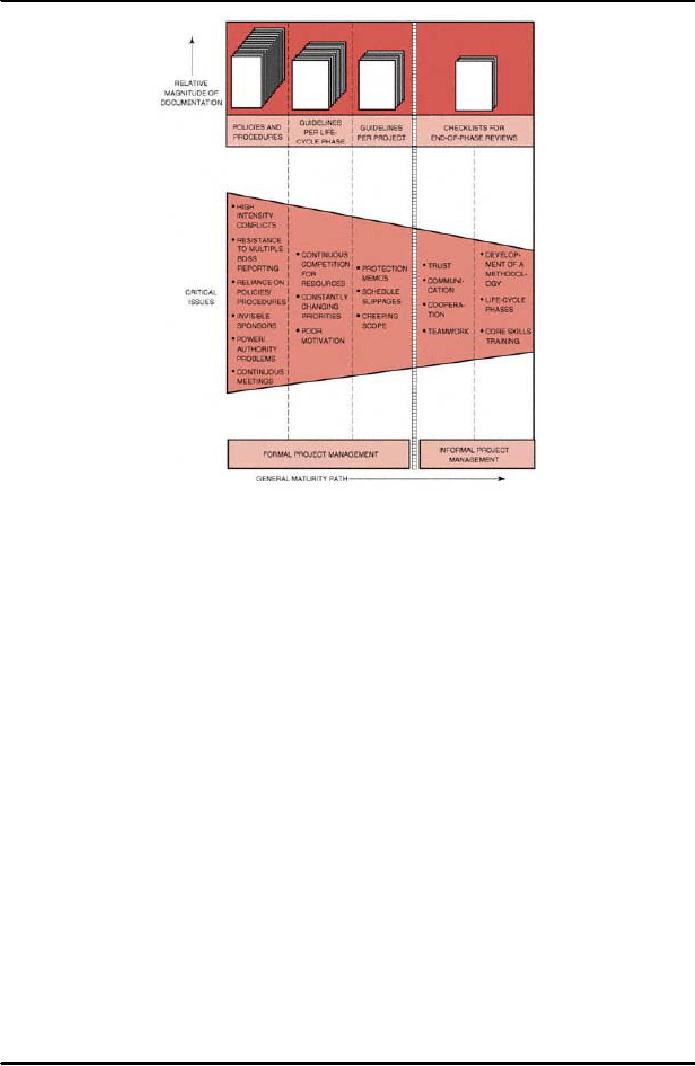
Project
Management MGMT627
VU
Figure
5.1: Maturity
Path
5.2
Life
Cycle Phases of a System:
The
theoretical definitions of the life
cycle phases of a system can
be applied to a project.
These
phases
include:
�
Conceptual
�
Planning
�
Testing
�
Implementation
�
Closure
5.2.1
Conceptual
Phase:
The
first phase, the conceptual phase,
includes the preliminary evaluation of an
idea.
Most
important in this phase is a
preliminary analysis of risk and the
resulting impact
on
the time, cost, and performance requirements,
together with the potential
impact on
company
resources. The conceptual phase
also includes a "first cut"
at the feasibility of
the
effort.
5.2.2
Planning
Phase:
The
second phase is the planning
phase. It is mainly a refinement of the
elements
described
under the conceptual phase. The
planning phase requires a firm
identification
of
the resources to be required together
with the establishment of realistic time,
cost,
and
performance parameters. This phase
also includes the initial
preparation of all
documentation
necessary to support the system. For a
project based on
competitive
bidding,
the conceptual phase would include the
decision of whether to bid, and
the
planning
phase would include the
development of the total bid
package (i.e., time,
schedule,
cost, and performance).
37
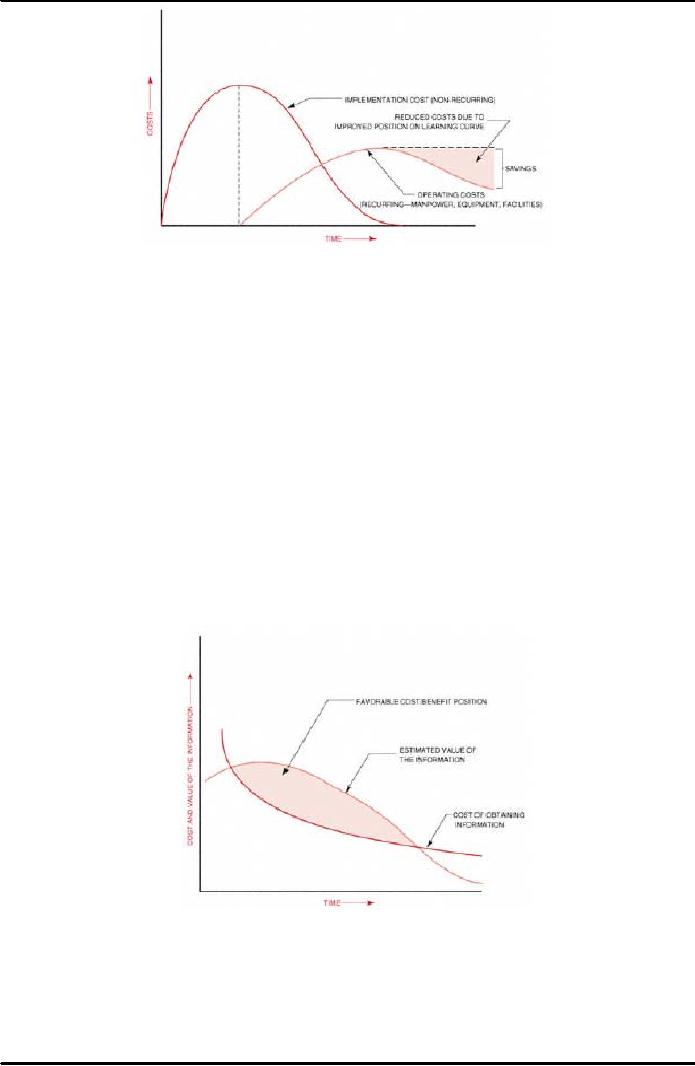
Project
Management MGMT627
VU
Figure
5.2: System
Costs
5.2.2.1
System Costs:
Because
of the amount of estimating involved,
analyzing system costs
during
the
conceptual and planning phases is not an
easy task. As shown in Figure
5.2,
most
project or system costs can
be broken down into
operating (recurring) and
implementation
(nonrecurring) categories. The
implementation costs
include
one-time
expenses such as construction of a
new facility, purchasing computer
hardware,
or detailed planning. Operating
costs, on the other hand,
include
recurring
expenses such as manpower.
The operating costs may be
reduced as
shown
in Figure 5.2, if personnel perform at a
higher position on the
learning
curve.
The identification of a learning
curve position is vitally
important during
the
planning phase when firm
cost positions must be
established.
Of
course, it is not always possible to
know what individuals will
be available
or
how soon they can
perform at a higher learning
curve position.
Figure
5.3: Cost
Benefit Analysis
5.2.2.2
Cost Benefit
Analysis:
Once
the approximate total cost of the
project is determined, a
cost-benefit
analysis
should be conducted (see Figure
5.3) to determine if the
estimated
38
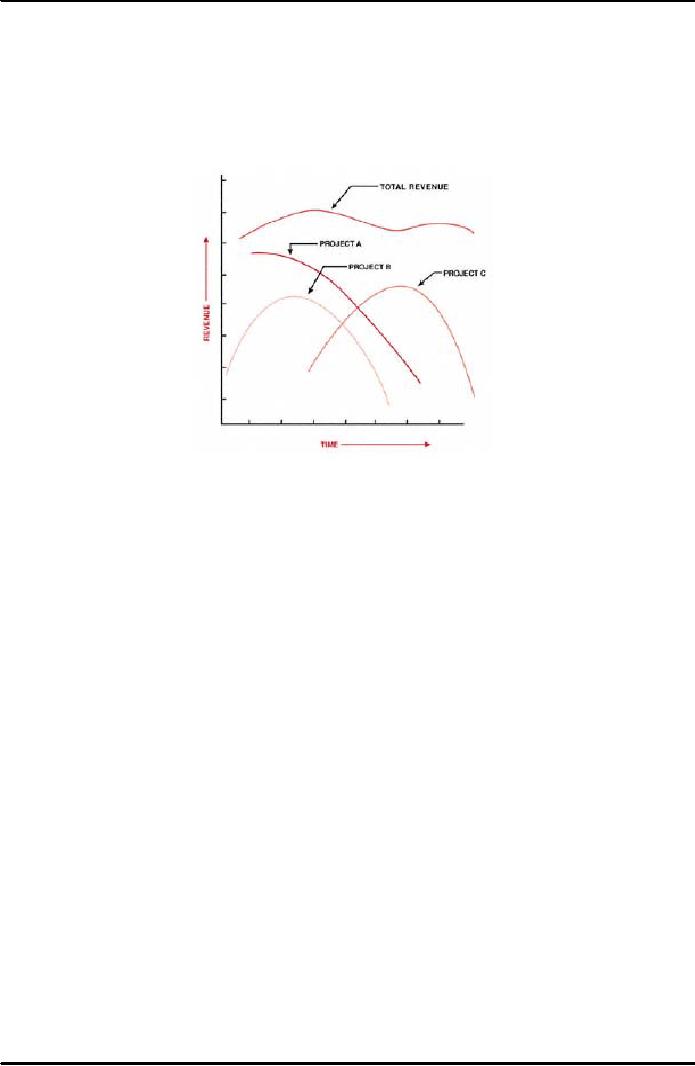
Project
Management MGMT627
VU
value
of the information obtained from the
system exceeds the cost of
obtaining
the
information. This analysis is often
included as part of a feasibility
study.
There
are several situations, such as in
competitive bidding, where the
feasibility
study is actually the conceptual and
definition phases. Because of
the
costs
that can be incurred during
these two phases, top-management
approval is
almost
always necessary before the
initiation of such a feasibility
study.
Figure
5.4: A
Stream of Projects
5.2.3
Testing
Phase:
The
third phase-- testing-- is
predominantly a testing and final
standardization effort
so
that operations can begin.
Almost all documentation
must be completed in this
phase.
5.2.4
Implementation
Phase:
The
fourth phase is the implementation
phase, which integrates the project's
product or
services
into the existing organization. If the
project was developed for
establishment of
a
marketable product, then this
phase could include the
product life cycle phases
of
market
introduction, growth, maturity, and a
portion of deterioration.
5.2.5
Closure
Phase:
The
final phase is closure and includes the
reallocation of resources. The
question to be
answered
is, "Where the resources should be
reassigned?" Consider a company
that
sells
products on the open consumer market. As one
product begins, the deterioration
and
death phases of its life
cycle (i.e., the divestment
phase of a system), then
new
products
or projects must be established. Such a company
would, therefore, require
a
continuous
stream of projects as a necessity for
survival, as shown in Figure 5.4.
As
projects
A and B begin their decline,
new efforts (project C) must
be developed for
resource
reallocation. In the ideal situation
these new projects will be established
at
such
a rate that total revenue will
increase and company growth
will be clearly
visible.
The
closure phase evaluates the efforts on the
total system and serves as
input to the
conceptual
phases for new projects and
systems. This final phase
also has an impact on
other
ongoing projects with regard to priority
identification.
Thus,
so far no attempt has been
made to identify the size of a
project or system.
Large
projects
generally require full-time staffs,
whereas small projects, although
they
undergo
the same system life cycle
phases, may require only
part-time people.
This
39
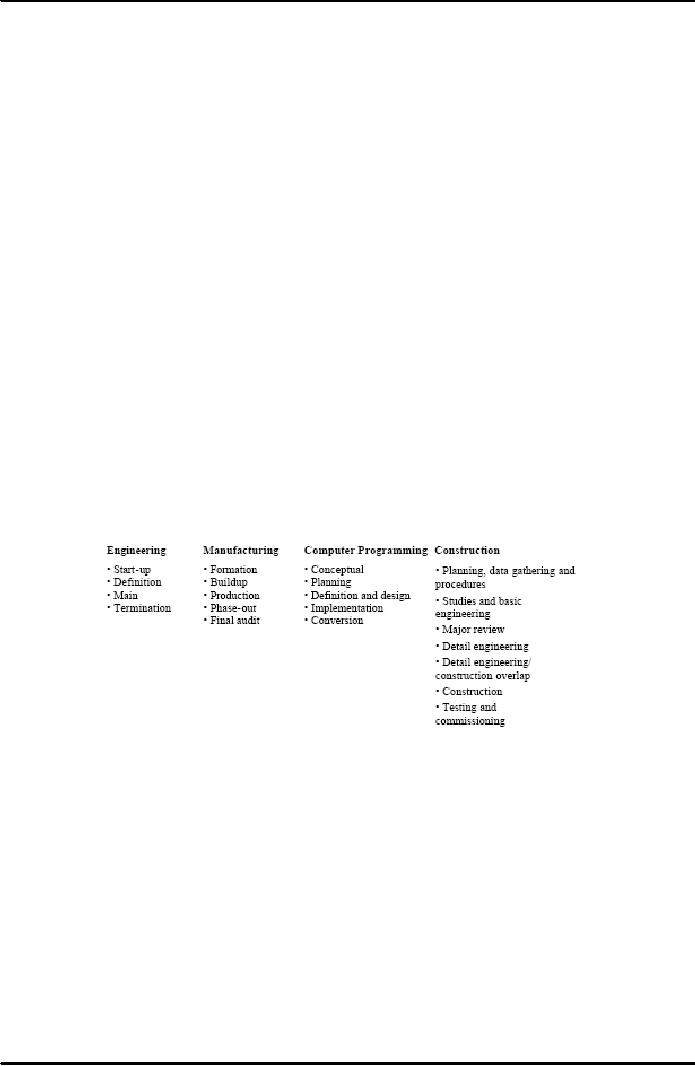
Project
Management MGMT627
VU
implies
that an individual can be responsible
for multiple projects, possibly
with each
project
existing in a different life
cycle phase.
The
following questions must be considered in
multi-project management:
1.
Are the project objectives the
same?
�
For
the good of the project
�
For
the good of the company
2.
Is there a distinction between large and
small projects?
3.
How do we handle conflicting
priorities?
�
Critical
versus critical projects
�
Critical
versus non-critical projects
�
Non-critical
versus non-critical projects
5.2.6
Explanation
of Various Life Cycle
Phases:
Later
topics discuss methods of resolving
conflicts and establishing
priorities.
The
phases of a project and
those of a product are
compared in Figure 5.5.
Notice that
the
life cycle phases of a
product generally do not
overlap, whereas the phases of
a
project
can and often do
overlap.
Table
5.1 identifies the various
life cycle phases that
are commonly used. Even
in
mature
project management industries
such as construction, one could
survey ten
different
construction companies and find ten
different definitions for the
life cycle
phases.
Table
5.1: Life
Cycle Phase
Definitions
The
life cycle phases for
computer programming, as listed in Table
above, are also
shown
in Figure 5.5 which
illustrates how manpower resources
can build up and
decline
during
a project. In Figure 5.5,
PMO stands for the present
method of operations, and
PMO'
will be the "new" present method of
operations after conversion. This
life cycle
would
probably be representative of a twelve-month
activity.
40
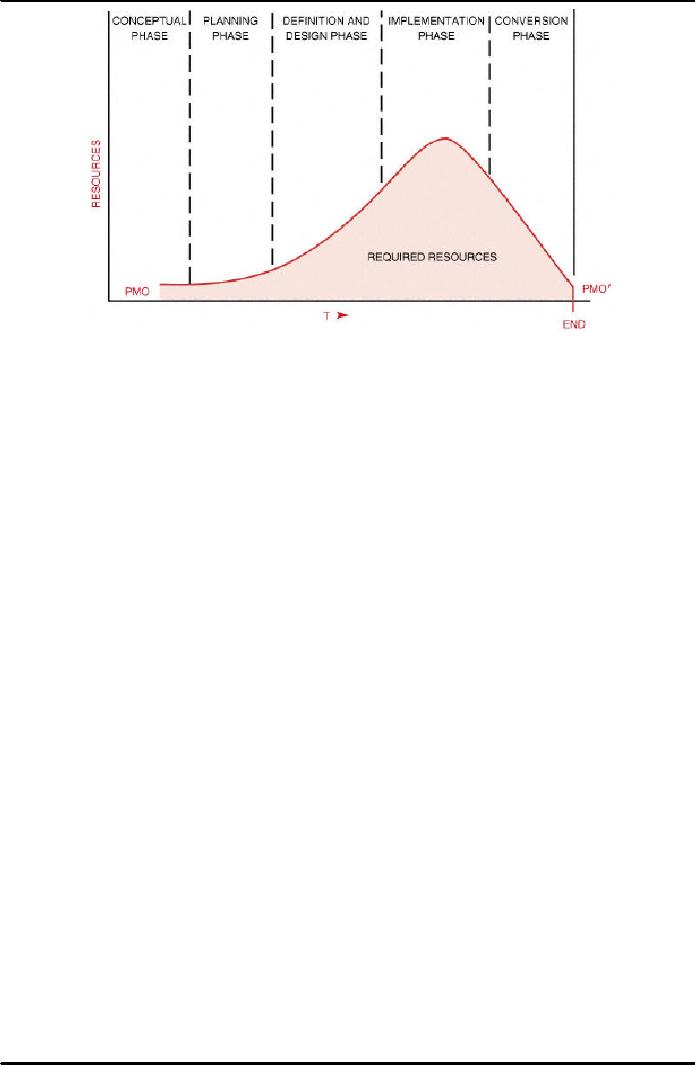
Project
Management MGMT627
VU
Figure
5.5: Definition
of a Project Life
Cycle
Most
executives prefer short data processing
life cycles because computer
technology
changes
at a very rapid rate. An executive of a
major utility commented that
his
company
was having trouble
determining how to terminate a computer
programming
project
to improve customer service because by
the time a package is ready
for full
implementation,
an updated version appears on the scene.
Should the original project
be
canceled
and a new project begun? The
solution appears to lie in
establishing short data
processing
project life cycle phases,
perhaps through segmented
implementation. In any
case,
we can conclude that top
management is responsible for the
periodic review of
major
projects. This should be accomplished, at a
minimum, at the completion of
each
life
cycle phase.
More
and more companies are preparing
procedural manuals for
project management
and
for structuring work using
life cycle phases. There
are several reasons for this
trend.
These
are as follows:
�
Clear
description of the work to be accomplished in
each phase may be
possible.
�
Pricing
and estimating may be easier if
well-structured work definitions
exist.
�
There
exists key decision points at the
end of each life cycle
phase so that
incremental
funding is possible.
Reader
should be aware that not
all projects can be simply
transposed into
lifecycle
phases
(e.g., Research and Development). In
such a case it might be possible
(even in
the
same company) for different
definitions of life-cycle phases to
exist because of
schedule
length, complexity, or just the
difficulty of managing the
phases.
41
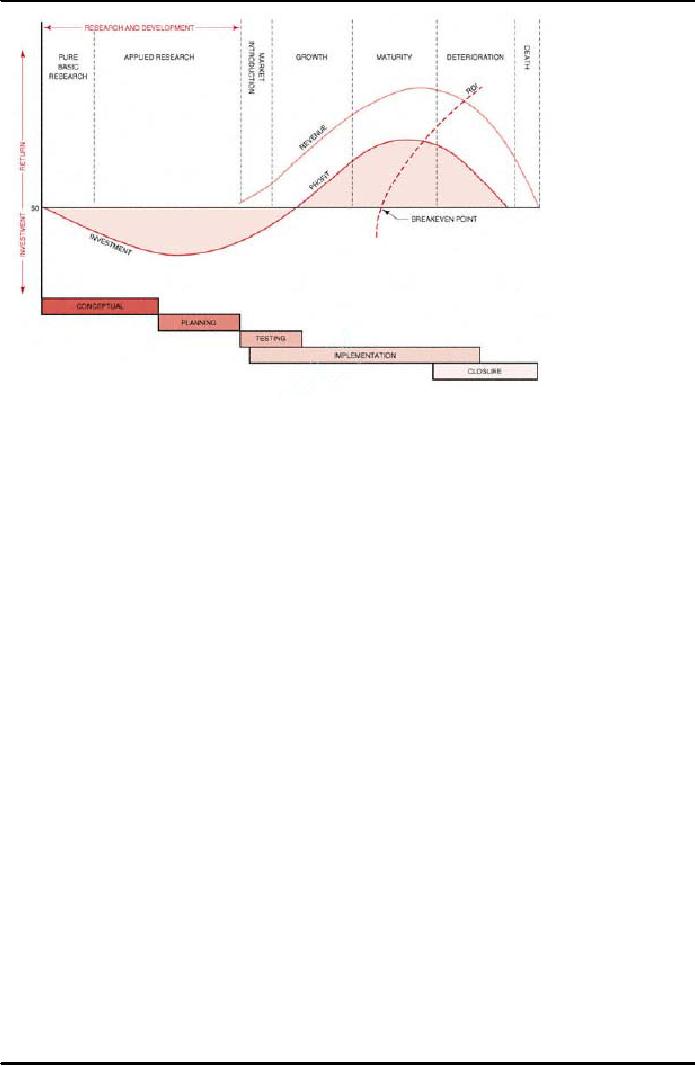
Project
Management MGMT627
VU
Figure
5.6: System/Product
Life Cycles
5.3
Characteristics
of Project Life Cycle:
�
Project
life cycle defines phases
that connect beginning and
end of the project. After
each
phase
deliverables are reviewed
for the completeness in time,
accuracy according to
defined
objectives
and their final approval
(approval for acceptance)
before moving to the
next
phase.
�
As
shown in the diagrams in the beginning, phases
can be overlapped to save
time and to
have
fast tracking on the life cycle.
This technique is used to
compress the whole
schedule
(if
required resources are
available or manageable)
�
There
is no way to define Project
Life Cycle ideally. Because
of this every project
management
team can define its
own way to work on the
project. They can use
best
common
practices and can learn
new ways of dealing projects by their
experiences in detail
or
in general. Only three phases
are always certain to be
performed; conceptualization,
intermediate
phase(s), and closure.
�
Generally
phases are defined in sequential
order by technical information
officer.
�
Cost
and staffing level is defined
for every single
phase.
�
Project
may have sub-project(s) and sub-projects may have
their own project life
cycle.
�
In
the beginning of the project, level of
uncertainty and risk is
always high.
�
The
typical project life cycle
initiating, implementing and
closing has critical
decision
points
where the project may continue, be
changed, or be abandoned.
�
There
are many points within the
project life cycle where
Community
of Professionals
(COPs)
may
provide support and guidance. For
example, initiating the project
involves
such
activities as identifying the project
team members, defining the
scope and business
objectives
of the project and identifying key
stakeholders.
42

Project
Management MGMT627
VU
�
During
project close, reassignment and
intelligent preservation of resources,
knowledge
projects
(i.e. deliverables), and sharing lessons
learned are facilitated.
5.4
Project
Management Office:
The
Project Management Office
sets project standards and
oversees the organization's
portfolio
of
projects. This allows the organization to
evaluate the use of resources
across all projects
and
resolve
conflicts that affect
project timelines. The
Project Management Office is
also a very
good
place to examine how communities
are linked across projects.
Using the communities as
the
linkage point for knowledge
transfer is far more efficient for the
following several reasons:
�
In
communities, the evaluation of knowledge
is generally done by a broader range of
people,
ensuring that the ideas are
more completely vetted.
�
Communities
generally exist outside the
project framework and trust is already
established.
�
They
can be used as opposed to
setting up more formal structures and
methods to get the
required
information transferred to the
project.
�
In
communities, knowledge is transferred
from expert to recipient.
This includes tacit
knowledge
transfer as well as explicit knowledge
transfer. This is a much more
efficient
transfer
mechanism than is normally
used. Generally, documents
would be transferred from
project
to project with minimal
expert knowledge available to add
value.
�
Community
transfer shares the knowledge broadly,
strengthening the entire organization
for
future
projects.
�
As
mentioned earlier, Project
Management Office and top
management are responsible
for
the
periodic review of major projects.
This should be accomplished, at a
minimum, at the
completion
of each life cycle
phase.
5.5
Project
Management Officer
(PMO):
Project
Management Officer (PMO) centralizes
and coordinates management of project
under
his
domain, and oversees management of
project and product (system/program)
both. Project
Management
Officer may not be directly
related to the project at spot. He/she
focuses on
coordination
planning, prioritization of all
resources and deliverables of projects and
sub
projects.
It is the responsibility of Project
Management Officer to keep top
management and
clients/parents
organization connected and informed
about all projects running or
product life
cycle.
He/she is involved in selection, management and
re-deployment of shared projects
as
much
as authorized.
Project
Management Officer is generally
responsible for:
�
Providing
monitoring platform for
Project Manager.
�
Identifying
the Project Management Methodology
and best practices for
specific project.
�
Clearing
house, i.e. defining and
refining project policies,
procedures, templates and
shared
documents.
�
Configuration
management for all projects
under work.
�
For
developing and keeping repository
and risk management for
projects.
43

Project
Management MGMT627
VU
�
Developing
Project Management Office
for operation and maintaining
tools for project
management.
Normally it includes Enterprise Wide
Project Management Software
creation
and
installation.
�
Management
and coordination and monitoring of communications
across the projects,
project
timelines and budget, quality
standards.
�
Project
Management Officer may be
having authority to terminate
project anytime when
he
gets
it not feasible
anymore.
5.6
Difference
Between Project Manager and Project
Management Officer:
1.
Both have different objectives -
driven by different requirements, aligned
with strategic
needs
of organization.
2.
Project Manager is responsible for
delivering specific project
objectives within
project
constraints,
while Project Management
Officer is responsible for organizational
structure
specific
mandates having much vast
perspective.
3.
Project Manager focuses on
project objectives, while
Project Management Officer
focuses
on
major programs, scope and changes
required and authenticated. Project
Management
Officer
considers all potential
opportunities to have business goals
achieved.
4.
Project Manager is constrained with
assigned resources for
specific project to meet its
full
objective.
On the other hand, Project Management
Officer is supposed to optimize the
use
of
shared organizational resources
across all projects
overall.
5.
Project Manager manages
scope, schedule, cost, and
quality of product, while the
Project
Management
Officer manages overall
risk, opportunities, interdependencies and
links
among
different projects.
6.
Project Manager reports on project
progress/project specific information to the
top
management,
while Project Management
Officer provides consolidated
reporting/enterprise
view
of project or all the running
projects.
5.7
Some
Examples of Project Life
Cycle:
There
are many variations on the
theme of the project phases,
influenced by the project's
scope
of
work. The project phase
selected in the examples here are
arbitrary and serve only
to
illustrate
the technique for different types of
projects. The main features to
look for are the
key
issues,
key activities, limiting factors,
decision and hold points in
each phase.
The
project life cycle is
conveniently represented by a bar chart
which clearly indicates
the
duration
of each phase and its
overlap (if any) with the
other phases.
5.7.1
House
Project:
The
construction of a house provides a
project many of us have personally
experienced.
Consider
here the following simple
sub-division into four
phases.
The
level of effort follows the
typical life cycle profile
by increasing to a maximum
during
the building phase before
declining during the interior
phase.
44
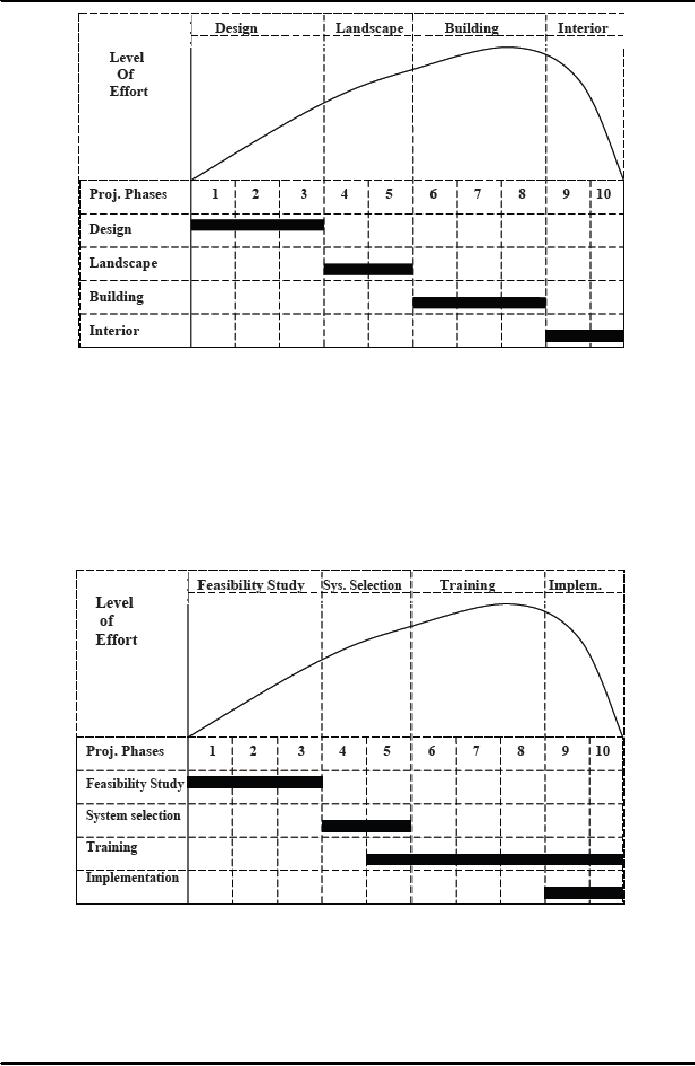
Project
Management MGMT627
VU
Figure
5.7: Project
Life Cycle: House
Project
5.7.2
Computer
installation:
With
the improved cost effectiveness of computer
facilities most companies
will
experience
a computer installation project sooner or
later.
Note
that the training phase
overlaps with both system
selection and the implementation
phase.
Figure
5.8: Project
Life Cycle: Computer
Installation
5.7.3
Engineering
Project:
An
engineering type project is a
popular example to illustrate the
project phases. Note
here
that all phases overlap
which could indicate a fast
tracking.
45
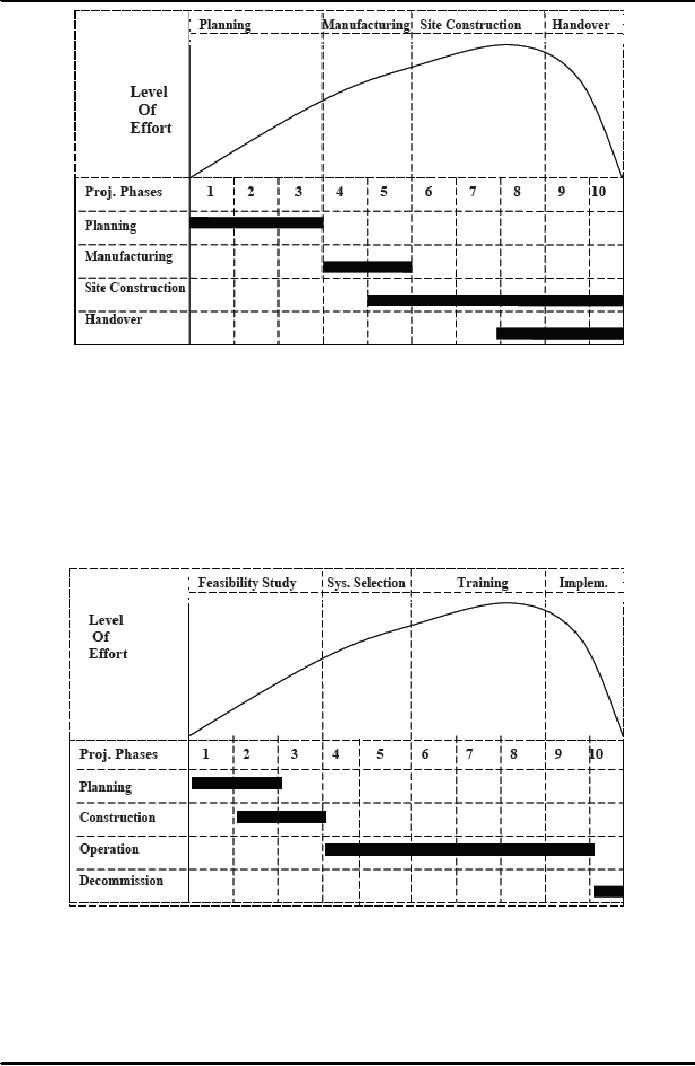
Project
Management MGMT627
VU
Figure
5.9: Project
Life Cycle: Engineering
Project
5.7.4
Nuclear
Power Station Project:
This
project may well span 50
years with the people
involved in the initial phases
being
retired
long before the final
phases.
The
interesting point here is
that the environmental constraints have
changed
significantly
over the fifty years between the design
phase and the decommissioning
phase.
Figure
5.10: Project
Life Cycle: Nuclear Power
Station Project
46
Table of Contents:
- INTRODUCTION TO PROJECT MANAGEMENT:Broad Contents, Functions of Management
- CONCEPTS, DEFINITIONS AND NATURE OF PROJECTS:Why Projects are initiated?, Project Participants
- CONCEPTS OF PROJECT MANAGEMENT:THE PROJECT MANAGEMENT SYSTEM, Managerial Skills
- PROJECT MANAGEMENT METHODOLOGIES AND ORGANIZATIONAL STRUCTURES:Systems, Programs, and Projects
- PROJECT LIFE CYCLES:Conceptual Phase, Implementation Phase, Engineering Project
- THE PROJECT MANAGER:Team Building Skills, Conflict Resolution Skills, Organizing
- THE PROJECT MANAGER (CONTD.):Project Champions, Project Authority Breakdown
- PROJECT CONCEPTION AND PROJECT FEASIBILITY:Feasibility Analysis
- PROJECT FEASIBILITY (CONTD.):Scope of Feasibility Analysis, Project Impacts
- PROJECT FEASIBILITY (CONTD.):Operations and Production, Sales and Marketing
- PROJECT SELECTION:Modeling, The Operating Necessity, The Competitive Necessity
- PROJECT SELECTION (CONTD.):Payback Period, Internal Rate of Return (IRR)
- PROJECT PROPOSAL:Preparation for Future Proposal, Proposal Effort
- PROJECT PROPOSAL (CONTD.):Background on the Opportunity, Costs, Resources Required
- PROJECT PLANNING:Planning of Execution, Operations, Installation and Use
- PROJECT PLANNING (CONTD.):Outside Clients, Quality Control Planning
- PROJECT PLANNING (CONTD.):Elements of a Project Plan, Potential Problems
- PROJECT PLANNING (CONTD.):Sorting Out Project, Project Mission, Categories of Planning
- PROJECT PLANNING (CONTD.):Identifying Strategic Project Variables, Competitive Resources
- PROJECT PLANNING (CONTD.):Responsibilities of Key Players, Line manager will define
- PROJECT PLANNING (CONTD.):The Statement of Work (Sow)
- WORK BREAKDOWN STRUCTURE:Characteristics of Work Package
- WORK BREAKDOWN STRUCTURE:Why Do Plans Fail?
- SCHEDULES AND CHARTS:Master Production Scheduling, Program Plan
- TOTAL PROJECT PLANNING:Management Control, Project Fast-Tracking
- PROJECT SCOPE MANAGEMENT:Why is Scope Important?, Scope Management Plan
- PROJECT SCOPE MANAGEMENT:Project Scope Definition, Scope Change Control
- NETWORK SCHEDULING TECHNIQUES:Historical Evolution of Networks, Dummy Activities
- NETWORK SCHEDULING TECHNIQUES:Slack Time Calculation, Network Re-planning
- NETWORK SCHEDULING TECHNIQUES:Total PERT/CPM Planning, PERT/CPM Problem Areas
- PRICING AND ESTIMATION:GLOBAL PRICING STRATEGIES, TYPES OF ESTIMATES
- PRICING AND ESTIMATION (CONTD.):LABOR DISTRIBUTIONS, OVERHEAD RATES
- PRICING AND ESTIMATION (CONTD.):MATERIALS/SUPPORT COSTS, PRICING OUT THE WORK
- QUALITY IN PROJECT MANAGEMENT:Value-Based Perspective, Customer-Driven Quality
- QUALITY IN PROJECT MANAGEMENT (CONTD.):Total Quality Management
- PRINCIPLES OF TOTAL QUALITY:EMPOWERMENT, COST OF QUALITY
- CUSTOMER FOCUSED PROJECT MANAGEMENT:Threshold Attributes
- QUALITY IMPROVEMENT TOOLS:Data Tables, Identify the problem, Random method
- PROJECT EFFECTIVENESS THROUGH ENHANCED PRODUCTIVITY:Messages of Productivity, Productivity Improvement
- COST MANAGEMENT AND CONTROL IN PROJECTS:Project benefits, Understanding Control
- COST MANAGEMENT AND CONTROL IN PROJECTS:Variance, Depreciation
- PROJECT MANAGEMENT THROUGH LEADERSHIP:The Tasks of Leadership, The Job of a Leader
- COMMUNICATION IN THE PROJECT MANAGEMENT:Cost of Correspondence, CHANNEL
- PROJECT RISK MANAGEMENT:Components of Risk, Categories of Risk, Risk Planning
- PROJECT PROCUREMENT, CONTRACT MANAGEMENT, AND ETHICS IN PROJECT MANAGEMENT:Procurement Cycles